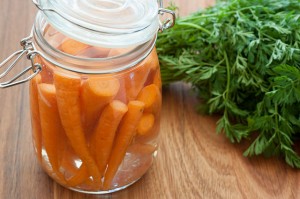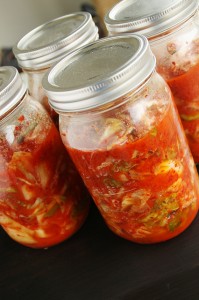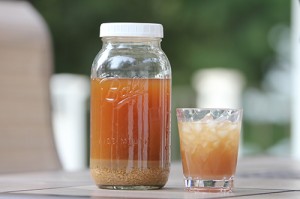You would need to be living under a rock if you were not aware that fermented/cultured food is all the go at the moment. On social media there are people taking pictures of their home-made fermented products, the paleo people are talking about them, in your health food store there are fermented products ready to go. But is the sudden interest in fermented foods simply a food fad?
Fermenting foods has been around since the beginning of time and the first fermented drink made by humans was believed to have been an alcoholic beverage made from fruit, rice, honey and dates around 7000-6600 BCE!!
So although we only recently seem to have realised how good fermented foods can be for us (in the western world) they have in fact been around since Neolithic times and over the years fermenting has mainly been part of our food production being used as preservatives.
Alcohol probably is the most recognised fermented drink, but when I am talking fermented foods I am not including alcohol. I am talking the fermented foods that are helping to give us good bacteria. Fermented foods contain good bacteria which is developed in the fermenting process. Usually sugar is used to feed the bacteria /yeasts in the product.
The list of fermented or “cultured” foods includes:
- Yoghurt – most people wouldn’t necessarily realise this is a cultured food. Most yoghurts on the market generally have good bacteria in them – most well known are Lactobacillus and Bifidobacterium genuses – just make sure your yoghurt isn’t full of sugar too.
- Kefir – traditionally made on milk and is much stronger than yoghurt, there are now varieties that are non-dairy such as made form coconut milk, rice milk, coconut water and even ginger.
- Miso – traditionally made from fermented soybeans, unpasturised is the best form of miso.
- Kombucha – a fermented drink made on either black/green tea with a variety of bacteria and yeasts.
- Tempeh – is usually and traditionally made from fermented soy beans (a little different to tofu), but there are now varieties made on other legumes such as chickpeas
- Sauerkraut/Kimchi – Sauerkraut has been eaten throughout history mainly in eastern Europe and Germany. Its fermented cabbage by lactic acid bacteria which can give a sour flavour. Kimchi is similar but usually has more spices added as it is a traditional Korean dish. Kimchi also often is made from radish or cucumber.
- Cultured cheeses – not only is cottage cheese on this list, but there are now non-dairy cashew cheeses on the market that are cultured with good bacteria.
- Pickles or fermented vegetables – just make sure any store bought pickles aren’t just done in a vinegar solution but actually have the good bacteria (or make your own).
You can ferment foods at home using the natural bacteria on the food “wild fermenting” or you can buy culture starters eg starters to help with yoghurt (dairy and non-dairy based), those to help with your fermented vegetables, kefir etc.
Fermented foods are so good for us as they contain probiotics. The World Health Organisation has given the definition of a probiotic as a “live micro-organisms which, when administered in adequate amounts, confer a health benefit of the host”. We want to make sure we have healthy colonies of the good bacteria (probiotics) living in our gut (there are literally hundreds of different types). If we have the right balance of good bacteria our immune system greatly benefits – 80% of our immune system is in our gut. Can help to protect against the development of food sensitivities/intolerances and maintains the health of our internal mucosa. Probiotics are good detoxifiers capable of drawing out a range of toxins. Also good bacteria is important for a healthy functioning digestive system which then can impact such things as behaviour, Autsim and development of diabetes. Fermented foods are also high in vitamins K2 (not found in a lot of foods) and B vitamins (especially B12).
Fermented foods can be eaten all year round in the above various different varieties to help maintain those levels of good bacteria.
It’s good to start slow so your intestinal microbiota adjusts to the changes. Start with 1/2 a teaspoon a day and work your way to around 2 tablespoons or more depending on the product and how you feel.
Some commercially processed fermented products are actually pasturised, so beware of what products you are buying (this heating process actually kills the good bacteria). Some vegetables are simply pickled and not actually fermented. One very well know fermented drink commercially produced is Yakult and this product should be avoided as it has 3.2 teaspoons of sugar per 99ml. This amount of sugar will actually feed the bad bacteria in your gut and not actually give you much good bacteria.
PREbiotics is also important to mention as this often gets forgotten in all the talk of PRObiotics. PREbiotics are the foods that feed the good bacteria. You want to make sure you are feeding those good guys you are putting into your body. Inulin is one of the main foods for probiotics and examples of foods that are high in inulin include Jerusalem artichokes (having the highest levels), leeks, asparagus, chicory root, garlic, onions, some whole grains, some fruits and honey.
So no I don’t believe fermented foods is a food fad. The manufacturers may have jumped onto the bandwagon to commercialise these foods, but I believe people of all cultures will continue to eat fermented foods either home-made or now via convenience food and it’s a good fad to be a part of!
Megan is a qualified nutritionist who specialises in digestive problems and likes to use whole foods as much as possible to see positive changes in the body. Contact her on megan@balancingnutrition.com.au for more information or click here to book an appointment with her.



